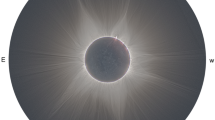Abstract
The relations between variations of far UV (FUV) emission in 115–210 nm waveband and Lα 121.6 nm and F10.7 are studied. The changes of FUV flux are found to lag changes of F10.7 - as a rule for 1 day. It is shown that such a difference may be caused by two factors: 1) differences between the rates of decrease of local sources' (active regions) brightness in FUV and 10.7 cm; 2) differences between limb-darkening curves for different wavelengths. One may expect the fluxes at different wavelengths to exhibit phase shifts of one relative to another. Cross-correlation analysis reveals no time-delay between emission fluxes within the FUV waveband, in spite of different laws for limb-brightening (darkening) for different spectral intervals. The absence of a phase delay can be caused by relatively small contribution of active regions to the flux of the whole Sun at these wavelengths. Thus the Lyman-alpha line intensity variation reflects variations of Solar FUV emission more precisely than F10.7. Therefore, using the Lα intensity for flux intensity calculations of other FUV wavelengths is preferable to using the F10.7 index.
Similar content being viewed by others
References
Bocharova, N. Yu., Nusinov, A. A.:1983,Solnechnye dannye (Rus. Solar Data) N 1, 106.
Cook, J. M., Brueckner, G. E., Van Hoosier, M. E.: 1980,J. Geophys. Res. A85, 2257.
Hinteregger, H. E.: 1981,Adv. Space Res. 1, No 12, 39.
Hedin, A. E.: 1987,J. Geophys.Res. A92, 4649.
Jacchia, L. G.: 1977, Spec. Report N 375 Smithsonian Inst. Astrophys. Observ.
Katyushina, V. V., Krasinetz, M. V., Nusinov, A. A., Barth, C. A., Rottman, G. J.:1991,Geomagnetizm i Aeronomya (Rus. Geomagnetizm and Aeronomy)31, 225.
Kazachevskaja, T. V., Gonyukh, D. A.: 1988,Solnechnye dannye (Rus. Solar Data) N 9, 88.
Krasinetz, M. V., Nusinov, A. A.: 1991,Solnechnye dannye (Rus. Solar Data) N 7, 88.
Lean, J. L., White, O. R., Livingston, W. S. et al.: 1982,J. Geophys. Res. A87, 10307.
Lean, J.: 1987,J. Geophys. Res. 1987D92, 839.
Nicolet, M., Bossy, L.: 1985,Planet Space Sci. 33, 507.
Nusinov, A., Kazachevskaja, T., Katyushina, V.: 1989,Solar-Terrestrial Prediction: Proc. of a Workshop at Leura. Australia1, 546.
Solar Geophysical Data. Prompt reports.: 1982–1990, NOAA USA.
Vernazza, J.E., Avrett, E.H., Loeser, R.: 1985,Astrophys. J. Suppl. Ser. 45, 635.
Vidal-Madjar, A., Pissammay, B.:1980,Solar Phys. 66, 259.
Author information
Authors and Affiliations
Rights and permissions
About this article
Cite this article
Nusinov, A.A., Katyushina, V.V. Lyman-alpha line intensity as a solar activity index in the far ultraviolet range. Sol Phys 152, 201–206 (1994). https://doi.org/10.1007/BF01473205
Issue Date:
DOI: https://doi.org/10.1007/BF01473205




